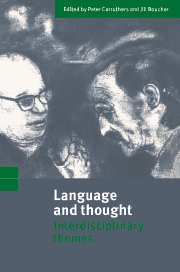Book contents
- Frontmatter
- Contents
- List of contributors
- Preface
- 1 Introduction: opening up options
- Part I Language, development and evolution
- Part II Language, reasoning and concepts
- Part III Language and conscious reasoning
- Introduction to part III
- 11 Language, thought and the language of thought (Aunty's own argument revisited)
- 12 Natural language and virtual belief
- 13 The meta-intentional nature of executive functions and theory of mind
- 14 Reflections on language and mind
- References
- Author index
- Subject index
Introduction to part III
Published online by Cambridge University Press: 08 January 2010
- Frontmatter
- Contents
- List of contributors
- Preface
- 1 Introduction: opening up options
- Part I Language, development and evolution
- Part II Language, reasoning and concepts
- Part III Language and conscious reasoning
- Introduction to part III
- 11 Language, thought and the language of thought (Aunty's own argument revisited)
- 12 Natural language and virtual belief
- 13 The meta-intentional nature of executive functions and theory of mind
- 14 Reflections on language and mind
- References
- Author index
- Subject index
Summary
The chapters in Part III all relate, more or less closely, to the distinction between conscious and non-conscious reasoning. As before, we say a few words of general introduction, before briefly commenting on each of the essays in this part of the book.
As we noted in chapter 1, one way of weakening the cognitive conception of language is by restricting its claims along a vertical (as opposed to horizontal, domain-specific) dimension – claiming that it is only conscious thought which crucially implicates language, and allowing that non-conscious thoughts may be carried by, for example, sentences of Mentalese or patterns of activation in a connectionist network. None of the chapters in Part III take quite this straightforward line (but see Carruthers, 1996a). Yet all pay attention to distinctions between kinds, or levels, of thinking – including the distinction between conscious and non-conscious thinking. (Note that the papers by Carruthers, chapter 5, and Clark, chapter 8, could also have been positioned in Part III, since much of their focus is on the role of language in conscious thought.) And all give at least some weight to the introspective datum that for much of the time our waking lives are occupied by a stream of ‘inner speech’, in which natural language words and sentences are imaged. This is certainly one of the battle-grounds on which the debate between cognitive and communicative conceptions of language needs to be played out, in our view.
- Type
- Chapter
- Information
- Language and ThoughtInterdisciplinary Themes, pp. 221 - 225Publisher: Cambridge University PressPrint publication year: 1998

